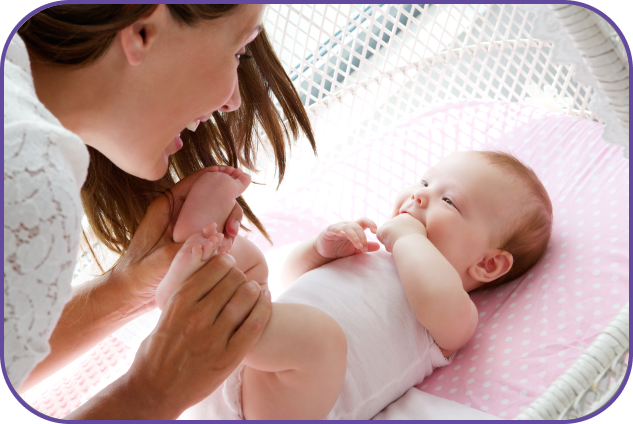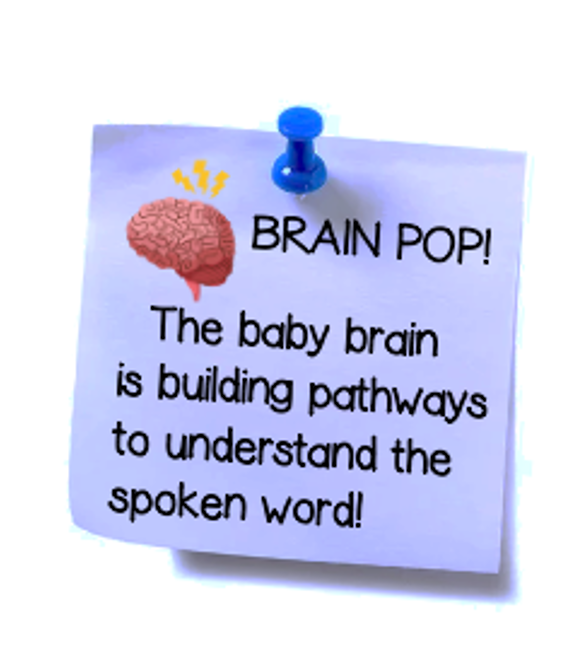The Developing

Listening is the receptive part of language, it’s the hearing and understanding of what the spoken word means. A baby is a captive audience of one, ready and able to hear voices and surrounding sounds. They are the receivers. Their ears are like antennas, always taking in the flow of sounds and words. It’s too early for infants to make any meaning, they’re just soaking in the abundant noises around them.
Listening does not happen without hearing! But hearing is not the same as listening! The ears are the pieces of the body that collect all the incoming sounds. These sound waves vibrate through the inner parts of the ears, creating signals that are transferred first to the brain stem, before going onto the brain. This physical action is called hearing. The sense of hearing tells what type of sound and its location: loud, soft, high, low, near, far. A newborns auditory sense (hearing) is fairly-well developed but it takes months before they recognize a variety of different sounds. The body’s hearing system is automatic and begins even before birth.
Resting and building up strength are part of what fills up the early weeks of an infant’s life. Soon this will change, and the baby will start to react more frequently to a variety of sounds. They may do the following in response to hearing a parent’s voice: smile in acknowledgement, move head towards the sound or use direct eye contact.
However, hearing a sound or word spoken by a parent does not mean there’s understanding. The brain is the master interpreter. It’s in charge of identifying, sorting, storing and making meaning of what has been heard. When the baby is older, the skills of hearing and translating the words into meaning will occur very fast, taking milliseconds. The brain’s ability to understand sounds-words is called auditory processing.


How does a baby learn about the world of listening? The exciting answer is experiences, experiences and more experiences! The learning brain gobbles up all the stimulus they’ve been exposed to and engaged in daily. This feeding frenzy of loving social interactions allows the baby to grow in their listening development. Parents sharing language by reading stories, singing songs and continuous talk, provide the necessary models for listening growth.
These listeners are watching, too! They are focusing on how sounds are physically pronounced by the speaker during these engaging interactions. This is a complex process that involves many parts of the baby brain. Networks are being built to strengthen the pathways needed to produce speech.
Once babies have started to recognize numerous sounds, they begin to undertake the job of learning how to understand what’s being heard. Here’s some important listening skills :
What’s the role of a parent? Being an engaged listener is important, the child becomes the sole focus and the center of one’s attention. It’s shown by giving them direct eye contact and responding to their communications.



Blumenrath, Sandra, PHD, MS, (2020), How Hearing Works, BrainFacts.org., https://www.brainfacts.org/thinking-sensing-and-behaving/hearing/2020/how-hearing-works-011020
Child Development-CDC, (2023), Early Brain Development and Health, https://www.cdc.gov/ncbddd/childdevelopment/early-brain-development.html
MED-EL, (2016), The Four Stages of Building Your Child’s Auditory Skills, https://blog.medel.com/tips-tricks/tips-tricks-for-parents/the-four-stages-of-building-your-childs-auditory-skills/
Riggs, Lori, MA, CC/SLP, (2009), National Association for Child Development , nacd journal, Auditory Processing – What is it? (Hearing vs. Processing), http://www.nacd.org/auditory-processing-what-is-it-hearing-vs-processing/
Stanford Medicine Children’s Health, Age-Appropriate Speech and Hearing,
https://www.stanfordchildrens.org/en/topic/default?id=age-appropriate-speech-and-hearing-milestones-90-P02169
